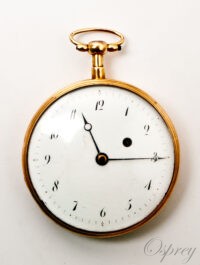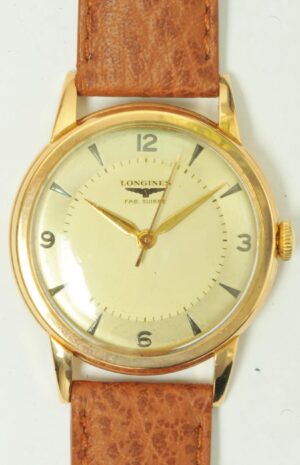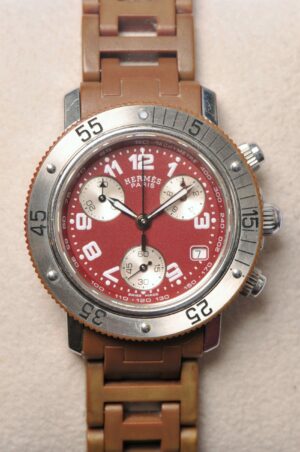cock watch
€1 600
Yellow gold “rooster” watch, verge escapement with crown wheel, spring force transmitted by chain. Osprey Paris
Out of stock
Yellow gold “rooster” watch, verge escapement with crown wheel, spring force transmitted by chain.
The first mechanical clocks, unlike water clocks, were invented in the 14th century. They were large and expensive machines operated with counterweights and mounted in the towers of prosperous cities. In the 16ᵉ century, the first table clocks were created; veritable triumphs of the watchmaker’s art, they indicated the time with a single hand on the flat top of the clock.
To compensate for the reduction in power of the spring as it discharged, these clocks used a small chain (like a miniature bicycle chain), wrapped around a cylinder and used to drive a cone-shaped pulley (more accurately a hyperboloid ). As the spring discharged, the chain descended along the cone, gradually pulling it at an angle more and more away from the central axis and therefore exerting more and more leverage.
The balance wheel, which required feats of perfection to beat regularly, was protected behind a finely engraved, pierced and gilded disc called the “coq”. These roosters were miniature works of art and took hours of work to produce. Delicate pillars separated the various plates of the clock and the whole was a marvel to behold and certainly a technological feat of the time.
As watchmakers improved their skills and the tools used to design the wheels and gears, it became possible to miniaturize the components, and thus to manufacture the first watches. These watches were bulky, cylinder-shaped, then round and apple-sized, with multiple pull-out covers to protect the delicate movement. Unsurprisingly, in France they were called onion watches . What is interesting is that they were perfect miniatures of table clocks and they kept the pillars and roosters for a very long time, although the latter were not easily visible, certainly because of tradition and to the watchmaker’s fierce pride in his work.
These early watches, even with silver cases, were expensive, and therefore not available to everyone. The watch was wound using a key placed in a hole in the dial and the time was adjusted by fitting the key into a square pinion which came out of the central axis of the hands. This maneuver required opening the glass cover, a delicate procedure that could notably scratch the enamel dial or cause the glass to fall. Subsequently, winding and time-setting could be done from the back of the watch, using two holes under the cover. The inventions that followed were those of the cylinder escapement followed by the lever escapement: the fragile chain became useless and the delicate watch cocks disappeared at the same time. The next step was to add a few more gears to allow the watch to be wound without a key by turning a crown. Initially, the time was adjusted by manipulating a small button or lever located around ten or even two o’clock on the side of the dial, then it was possible to do so by pulling the winder a little. (The lever system was retained for railroad watches to prevent accidental change of time; it was often even necessary to open the glass cover to access the lever.)
Watch movements were set with precious stones, usually rubies, to reduce wear and in principle the more rubies in a movement the better the quality. But it must be understood that rubies are not recoverable and do not add anything to the value of a movement good for scrap.
Osprey Paris
278 rue Saint-Honoré
75001 Paris
01 4015 9000









